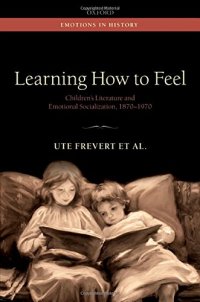
Ebook: Learning How to Feel: Children's Literature and the History of Emotional Socialization, 1870-1970
- Tags: Children s Literature Genres Styles History Criticism Fiction Sociology Abuse Class Death Marriage Family Medicine Race Relations Rural Social Theory Urban Politics Sciences Education Schools Teaching New Used Rental Textbooks Specialty Boutique American Creative Writing Composition English Literary World Humanities Africa Ancient Asia Europe Latin America Middle East Military United States
- Series: Emotions in History
- Year: 2014
- Publisher: Oxford University Press
- Edition: 1
- Language: English
- pdf
Learning How to Feel explores the ways in which children and adolescents learn not just how to express emotions that are thought to be pre-existing, but actually how to feel. The volume assumes that the embryonic ability to feel unfolds through a complex dialogue with the social and cultural environment and specifically through reading material. The fundamental formation takes place in childhood and youth. A multi-authored historical monograph, Learning How to Feel uses children's literature and advice manuals to access the training practices and learning processes for a wide range of emotions in the modern age, circa 1870-1970. The study takes an international approach, covering a broad array of social, cultural, and political milieus in Britain, Germany, India, Russia, France, Canada, and the United States.
Learning How to Feel places multidirectional learning processes at the centre of the discussion, through the concept of practical knowledge. The book innovatively draws a framework for broad historical change during the course of the period. Emotional interaction between adult and child gave way to a focus on emotional interactions among children, while gender categories became less distinct. Children were increasingly taught to take responsibility for their own emotional development, to find 'authenticity' for themselves. In the context of changing social, political, cultural, and gender agendas, the building of nations, subjects and citizens, and the forging of moral and religious values, Learning How to Feel demonstrates how children were provided with emotional learning tools through their reading matter to navigate their emotional lives.
Learning How to Feel places multidirectional learning processes at the centre of the discussion, through the concept of practical knowledge. The book innovatively draws a framework for broad historical change during the course of the period. Emotional interaction between adult and child gave way to a focus on emotional interactions among children, while gender categories became less distinct. Children were increasingly taught to take responsibility for their own emotional development, to find 'authenticity' for themselves. In the context of changing social, political, cultural, and gender agendas, the building of nations, subjects and citizens, and the forging of moral and religious values, Learning How to Feel demonstrates how children were provided with emotional learning tools through their reading matter to navigate their emotional lives.
Download the book Learning How to Feel: Children's Literature and the History of Emotional Socialization, 1870-1970 for free or read online
Continue reading on any device:

Last viewed books
Related books
{related-news}
Comments (0)